How to Keep Your Team Engaged During Meetings

Introduction
Keeping your team members engaged during meetings is crucial for enhancing productivity, stimulating creativity, and achieving better outcomes. However, many meetings fall short, leaving participants feeling disengaged, uninterested, or even irritated. In this blog post, we will dive into the significance of maintaining engagement during meetings, discuss the benefits of having engaged team members, and provide actionable strategies and best practices that you can implement in your own organization.
Throughout the article, we'll delve into the factors that influence team engagement during meetings and explore various tactics for keeping your team members involved. Additionally, we'll examine how technology can help enhance engagement, and address common challenges teams face while striving to maintain engagement in meetings. Ultimately, we'll equip you with the tools and knowledge necessary to transform your meetings into engaging, collaborative, and effective sessions that drive results and foster a positive team dynamic
Factors That Affect Team Engagement During Meetings
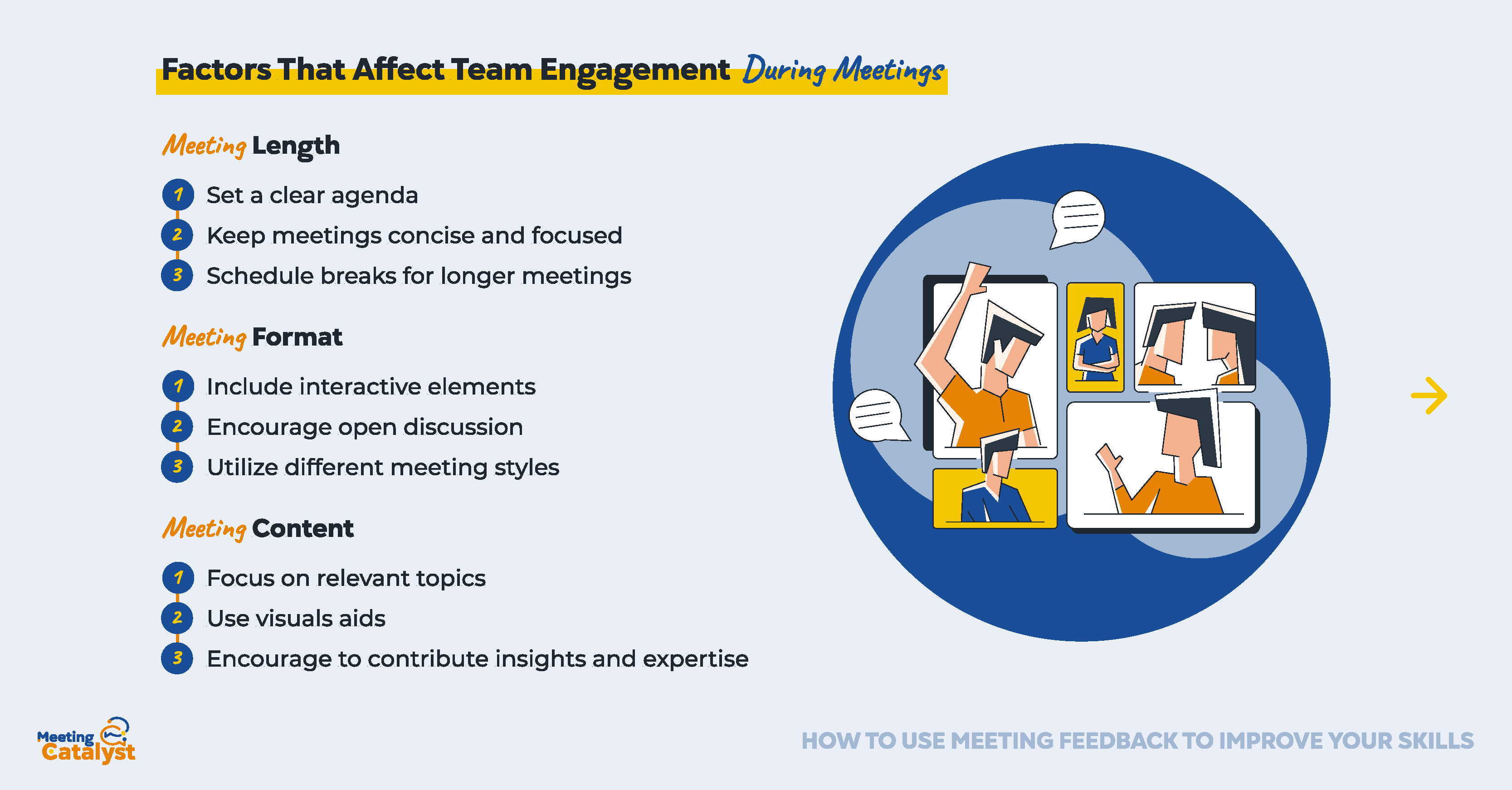
Understanding the factors that influence team engagement during meetings is essential for creating an environment that fosters collaboration and productivity. By addressing these factors, you can optimize your meetings to keep team members engaged and focused. In this section, we will discuss three key elements that can impact team engagement: meeting length, meeting format, and meeting content.
Meeting Length
The duration of a meeting can significantly impact engagement levels. Long, drawn-out meetings often lead to mental fatigue and disinterest, while excessively short meetings may not allow for adequate discussion and collaboration. To maintain engagement, it's important to:
- Set a clear agenda and allocate an appropriate amount of time for each topic.
- Keep meetings concise and focused, eliminating unnecessary discussions or tangents.
- Schedule breaks for longer meetings to give team members a chance to recharge.
Meeting Format
The format of a meeting can either facilitate engagement or stifle it. Traditional, lecture-style meetings may not be as effective as interactive sessions where team members have the opportunity to contribute and participate actively. To create a more engaging meeting format, consider:
- Including interactive elements, such as group activities, brainstorming sessions, or Q&A segments.
- Encouraging open discussion and debate to foster a sense of ownership and involvement.
- Utilizing different meeting styles, such as roundtable discussions or breakout groups, to cater to various team members' preferences and strengths.
Meeting Content
The relevance and interest of the meeting content play a crucial role in keeping team members engaged. When content is dull or unrelated to participants' roles or goals, engagement levels are likely to plummet. To ensure your meeting content promotes engagement:
- Focus on topics that are relevant, timely, and directly related to the team's objectives.
- Present information in a clear, concise, and visually appealing manner using visuals aids, such as slides or infographics.
- Encourage team members to contribute their own insights and expertise, fostering a sense of shared ownership and collaboration.
By carefully considering these factors when planning and leading meetings, you can create an environment that encourages active participation and keeps your team members engaged throughout the session.
Strategies for Engaging Your Team During Meetings
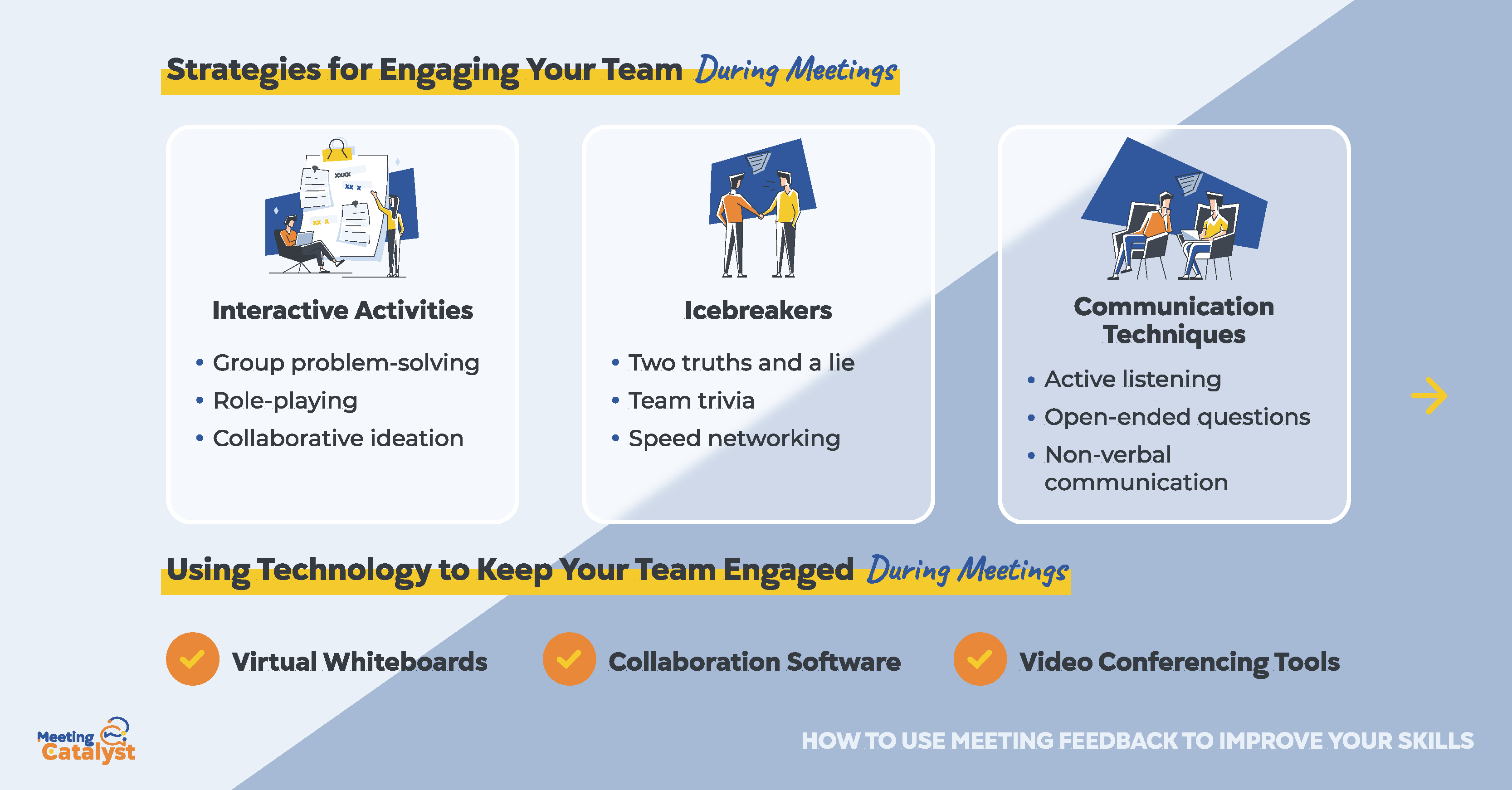
Keeping your team engaged during meetings is essential for fostering collaboration, creativity, and productivity. In this section, we will explore several strategies to increase engagement, including interactive activities, icebreakers, and effective communication techniques.
Interactive Activities
Incorporating interactive activities into your meetings can help break up monotony and promote active participation. Some examples of interactive activities include:
- Group problem-solving: Present a challenge or issue the team is facing and have team members work together to brainstorm and propose solutions.
- Role-playing: Simulate real-life scenarios and have team members take on different roles to practice their communication and decision-making skills.
- Collaborative ideation: Use techniques like mind mapping or affinity diagramming to encourage team members to contribute their ideas and collaborate on new projects.
Icebreakers
Icebreakers can be a valuable tool to help create a relaxed atmosphere, encourage team bonding, and stimulate creative thinking. Some effective icebreakers to consider include:
- Two truths and a lie: Have each team member share two true statements and one false statement about themselves, and have the rest of the team guess which one is the lie.
- Team trivia: Create trivia questions about your company, industry, or team members, and have team members compete in a friendly game.
- Speed networking: Pair team members up for short, timed conversations, and have them switch partners every few minutes to facilitate relationship-building and networking.
Effective Communication Techniques
Employing effective communication techniques can help maintain engagement and promote understanding during meetings. Some key communication techniques to consider are:
- Active listening: Demonstrate genuine interest in what team members are saying by maintaining eye contact, asking follow-up questions, and summarizing their points to confirm understanding.
- Open-ended questions: Encourage team members to think critically and express their thoughts by asking open-ended questions that require more than a simple yes or no answer.
- Non-verbal communication: Use body language, facial expressions, and gestures to convey enthusiasm and interest, and encourage team members to do the same.
By implementing these strategies in your meetings, you can create an engaging environment that promotes active participation and strengthens team dynamics. Remember to tailor these strategies to your team's unique needs and preferences for optimal results.
Using Technology to Keep Your Team Engaged During Meetings
In today's digital age, technology plays a crucial role in keeping team members engaged during meetings. In this section, we will discuss various technology tools that can enhance engagement, such as virtual whiteboards, collaboration software, and video conferencing tools.
Virtual Whiteboards
Virtual whiteboards are interactive online platforms that allow team members to brainstorm, collaborate, and visualize ideas in real-time. They can be particularly helpful in keeping remote team members engaged during meetings. Examples of virtual whiteboard tools include Miro, MURAL, and Stormboard. To use virtual whiteboards effectively:
- Encourage team members to actively participate by contributing their ideas, comments, and feedback on the whiteboard.
- Assign tasks or roles to team members, such as note-taker or facilitator, to ensure everyone is involved.
- Use templates or frameworks to provide structure and guide the discussion.
Collaboration Software
Collaboration software can help streamline communication, document sharing, and project management during meetings. Tools like Microsoft Teams, Slack, and Asana are excellent examples of collaboration platforms. To enhance team engagement with these tools:
- Use dedicated channels or threads for specific topics or projects, allowing team members to stay focused on relevant discussions.
- Encourage team members to share updates, ask questions, and provide feedback within the platform.
- Integrate the software with other tools, such as calendar apps or file-sharing services, to centralize information and streamline workflows.
Video Conferencing Tools
Video conferencing tools like Zoom, Google Meet, or Microsoft Teams enable face-to-face communication, which is essential for maintaining engagement during virtual meetings. To optimize the use of video conferencing tools:
- Encourage team members to turn on their cameras and use gallery view to create a more connected and interactive experience.
- Utilize features like screen sharing, polls, or breakout rooms to facilitate discussion and collaboration.
- Establish clear guidelines for video conferencing etiquette, such as muting microphones when not speaking and using non-verbal reactions to minimize disruptions.
By leveraging these technology tools and using them effectively, you can keep your team engaged and foster a collaborative meeting environment, regardless of whether your team is in-person or remote.
Overcoming Common Challenges to Team Engagement During Meetings
In this section, we will discuss common challenges to team engagement during meetings, such as distractions, disengaged team members, and meeting fatigue. We will also provide strategies to overcome these challenges, ensuring a more productive and engaging meeting experience.
Distractions
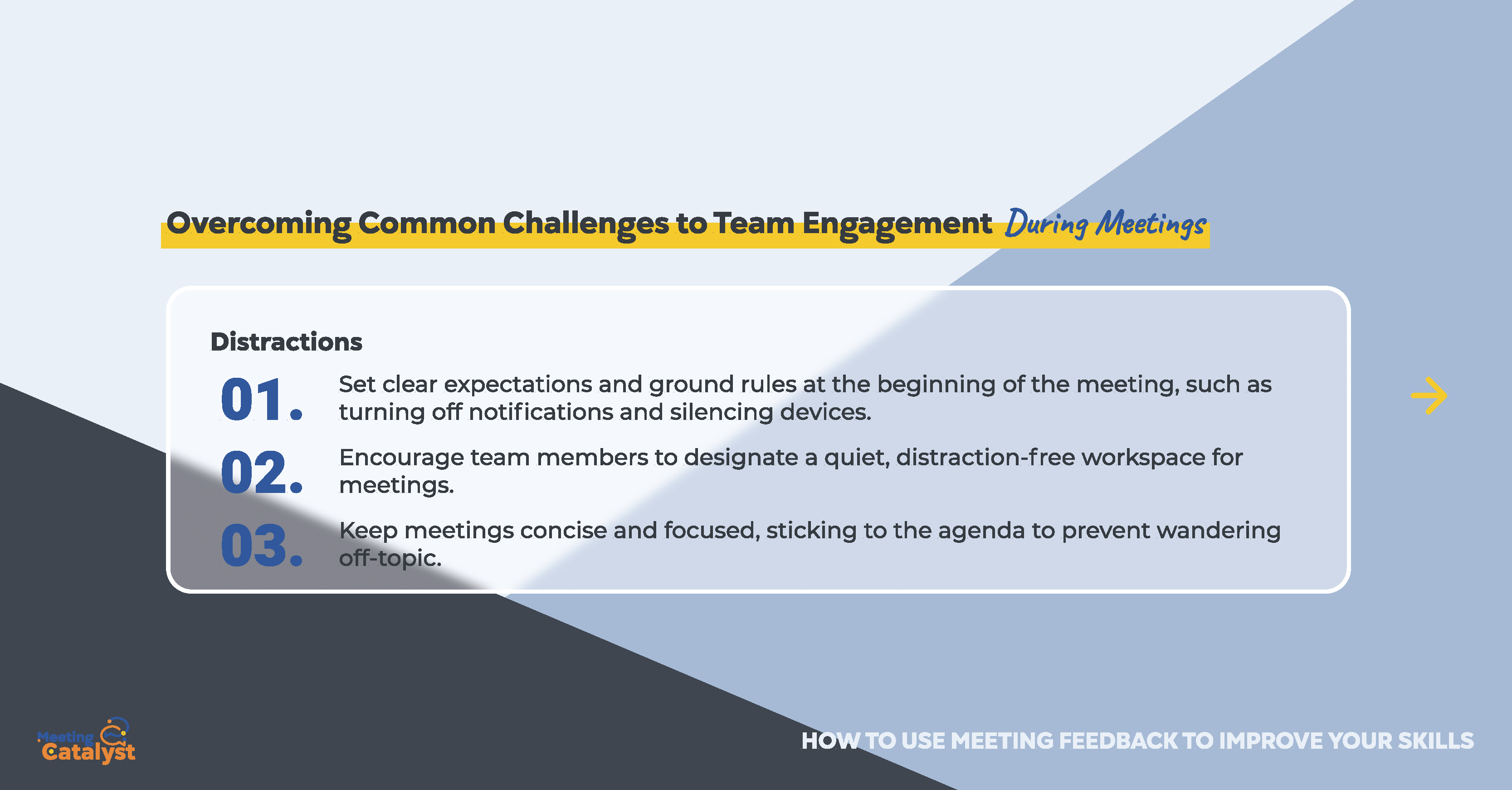
Distractions can derail a meeting and cause team members to lose focus. To minimize distractions and maintain engagement:
- Set clear expectations and ground rules at the beginning of the meeting, such as turning off notifications and silencing devices.
- Encourage team members to designate a quiet, distraction-free workspace for meetings.
- Keep meetings concise and focused, sticking to the agenda to prevent wandering off-topic.
Disengaged Team Members
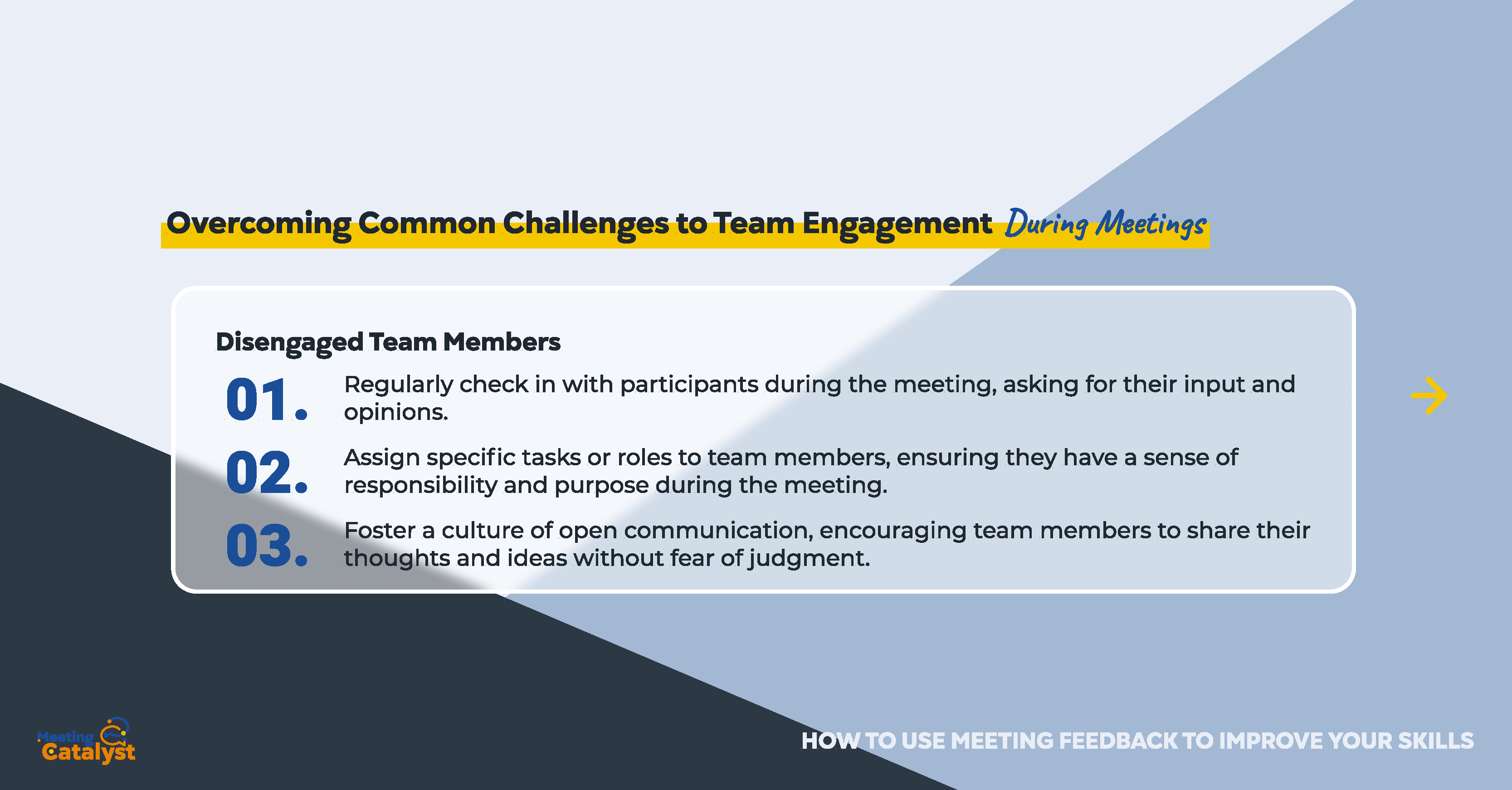
Disengaged team members can negatively impact the overall meeting experience. To increase engagement among team members:
- Regularly check in with participants during the meeting, asking for their input and opinions.
- Assign specific tasks or roles to team members, ensuring they have a sense of responsibility and purpose during the meeting.
- Foster a culture of open communication, encouraging team members to share their thoughts and ideas without fear of judgment.
Meeting Fatigue
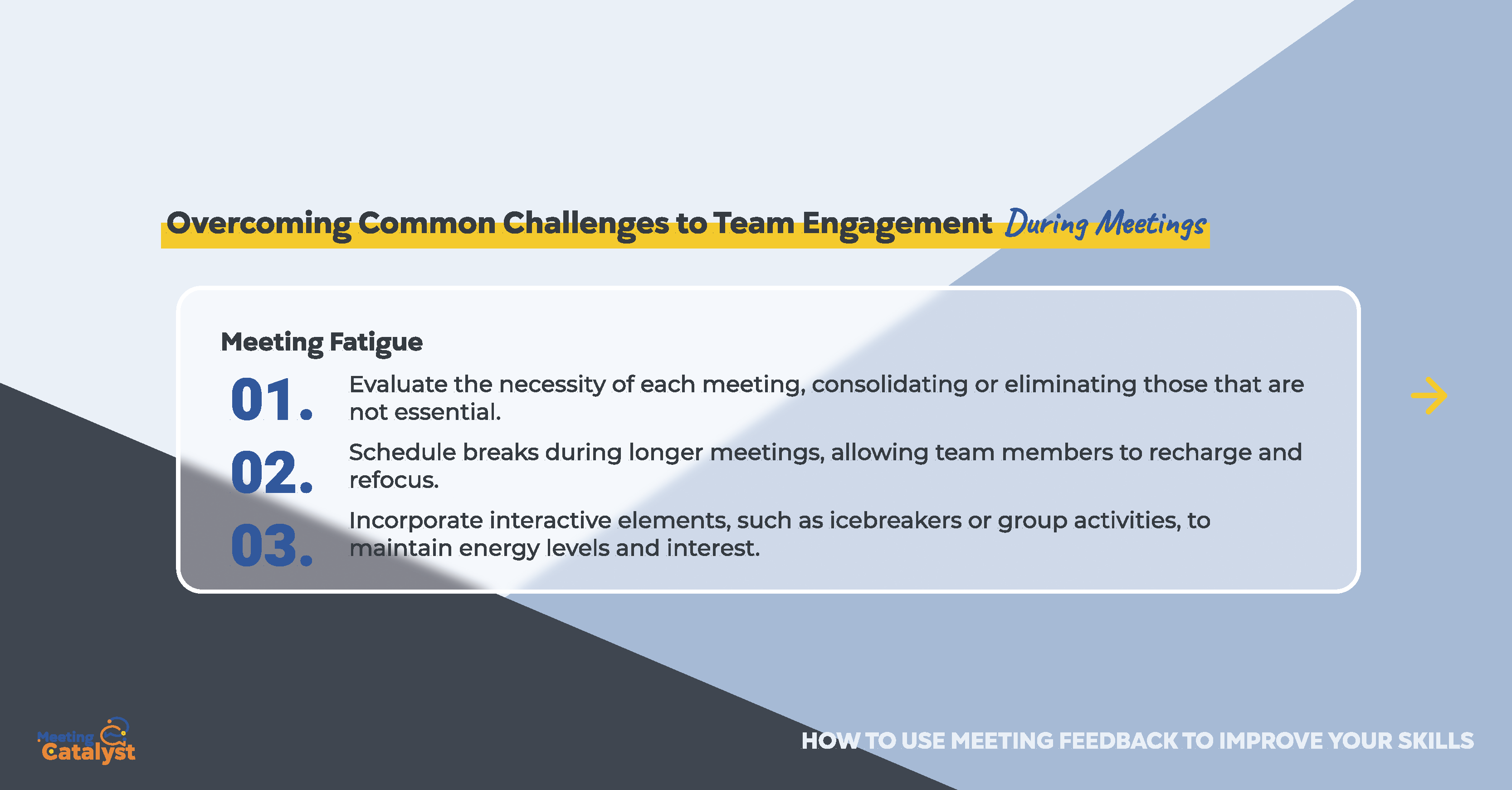
Meeting fatigue can occur when team members are overwhelmed with too many meetings or long, unproductive sessions. To combat meeting fatigue:
- Evaluate the necessity of each meeting, consolidating or eliminating those that are not essential.
- Schedule breaks during longer meetings, allowing team members to recharge and refocus.
- Incorporate interactive elements, such as icebreakers or group activities, to maintain energy levels and interest.
By addressing these common challenges and implementing the suggested strategies, you can create an engaging meeting environment that keeps your team focused and invested in the discussion.
Best Practices for Keeping Your Team Engaged During Meetings
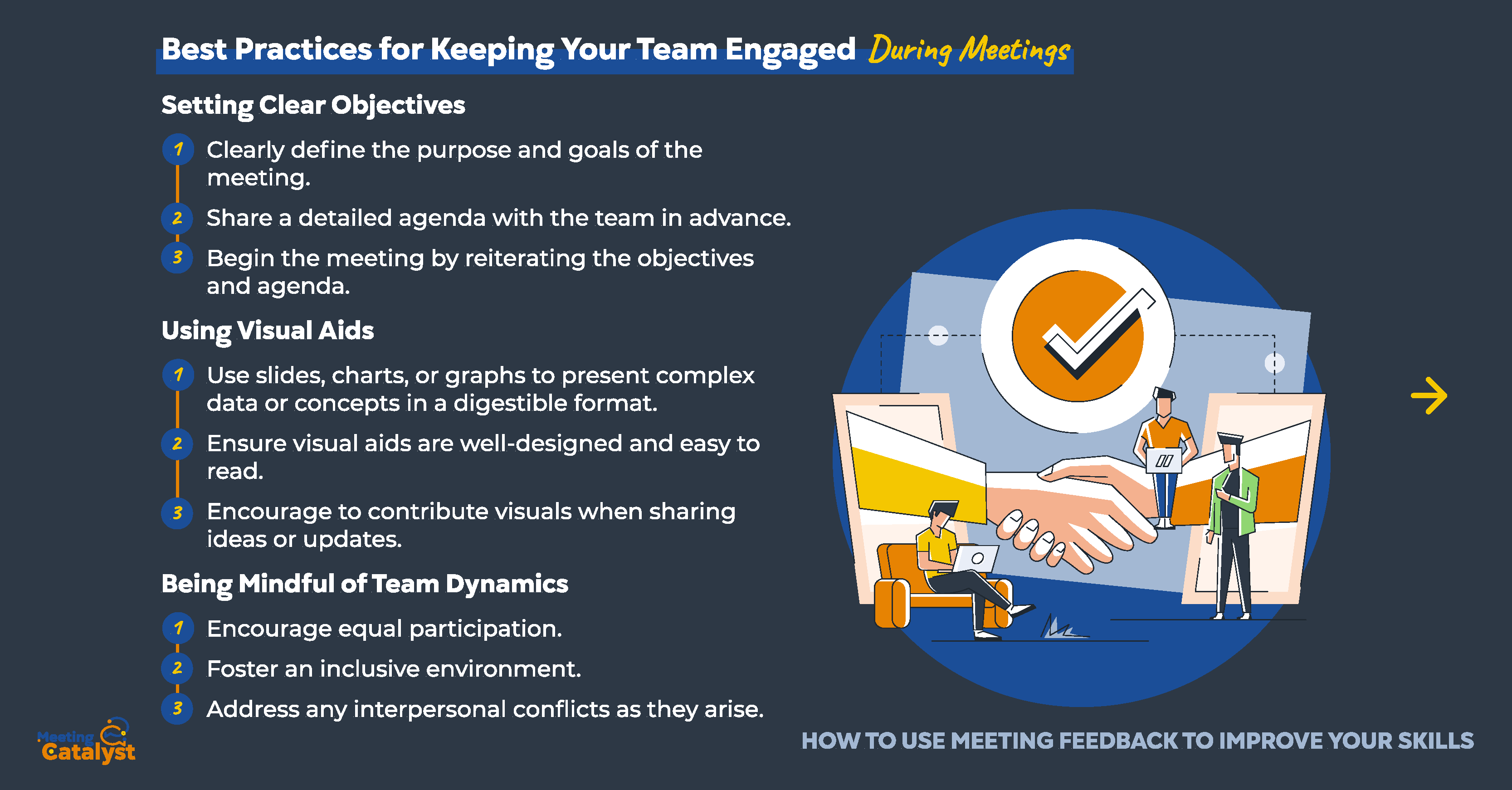
By implementing the best practices for keeping your team engaged during meetings practices, you can create an environment that fosters active participation and collaboration.
Setting Clear Objectives
Establishing clear objectives for each meeting is crucial in maintaining engagement. To do so:
- Clearly define the purpose and goals of the meeting when sending out invitations.
- Share a detailed agenda with the team in advance, outlining the discussion points and any required preparation.
- Begin the meeting by reiterating the objectives and agenda, ensuring everyone is aligned and focused.
Using Visual Aids
Visual aids can help team members process information more effectively and maintain focus. To incorporate visual aids in your meetings:
- Use slides, charts, or graphs to present complex data or concepts in a digestible format.
- Ensure visual aids are well-designed and easy to read, avoiding clutter and excessive text.
- Encourage team members to contribute their own visuals when sharing ideas or updates.
Being Mindful of Team Dynamics
Understanding and managing team dynamics is essential for maintaining engagement. Consider the following tips:
- Encourage equal participation by inviting input from quieter team members and managing dominating personalities.
- Foster an inclusive environment by valuing diverse perspectives and showing empathy towards team members' concerns or challenges.
- Address any interpersonal conflicts or tensions as they arise, promoting a collaborative and respectful atmosphere.
By implementing these best practices, you can create engaging and productive meetings that drive team collaboration and boost overall performance. Real-life examples of successful implementation of these best practices can be seen in organizations that prioritize effective communication and inclusivity, resulting in high levels of team engagement and satisfaction.
Conclusion
In conclusion, keeping your team engaged during meetings is essential for maximizing productivity, enhancing collaboration, and fostering a positive work environment. By understanding the factors that affect engagement and implementing strategies to address them, you can create meetings that are both engaging and effective.
Remember to:
- Consider factors such as meeting length, format, and content when planning your meetings.
- Employ a variety of strategies to engage your team, such as interactive activities, effective communication techniques, and icebreakers.
- Leverage technology to enhance engagement, using tools like virtual whiteboards and collaboration software.
- Overcome common challenges to team engagement, such as distractions and disengaged team members, by setting clear expectations and implementing meeting ground rules.
- Follow best practices for keeping your team engaged, such as setting clear objectives, using visual aids, and being mindful of team dynamics.
By embracing these principles and putting them into practice, you can elevate the quality of your meetings and drive positive outcomes for your team and organization. It's time to take action and transform your meetings into engaging, collaborative, and productive experiences for everyone involved.